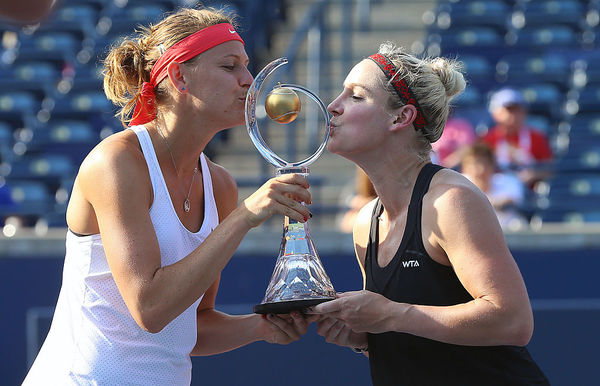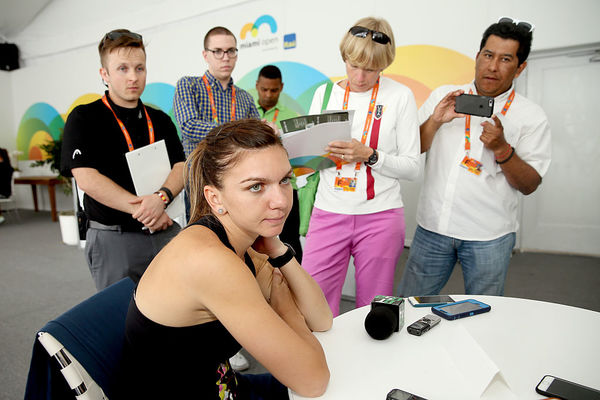Insider Doubles Take: Miami Heat
Santina In The Sun: Co-No.1s Martina Hingis and Sania Mirza come into the Miami Open at their most vulnerable since their partnership began, having won just won match since their winning streak of 41 straight came to an end at the Qatar Total Open. Santina took their first straight-sets defeat since last summer at the BNP Paribas Open, falling in the second round to doubles threats Vania King and Alla Kudryavtseva.
King and Kudryavtseva once again find themselves in Santina’s quarter of the draw, but the good friends will have to first get past nemeses Julia Goerges and Karolina Pliskova. Runners-up in Indian Wells, Goerges and Pliskova have ended both of King and Kudryavtseva’s quarterfinal runs at the Australian Open and again last week in the California desert. With both potential quarterfinal opponents for Hingis and Mirza, the reigning Wimbledon, US Open, and Australian Open champions will have their work cut out for them as they attempt to regain their stunning ascendency ahead of the clay court season and win their fifth title of 2016.
Team Bucie Reunites: Bethanie Mattek-Sands just won her first title since last summer’s Rogers Cup with CoCo Vandeweghe in Indian Wells – taking out No.2 seeds and sisters Chan Hao-Ching and Chan Yung-Jan along the way – but while her countrywoman rejoins regular partner Anna-Lena Groenefeld, Mattek-Sands will be joined by former partner Lucie Safarova in Miami. Mattek-Sands and Safarova were the stories of the start of 2016, getting halfway to the Calendar Year Grand Slam with wins in Australia and Paris.

Safarova’s injuries and illnesses – most recently a battle with reactive arthritis – have kept the team apart, but No.3 seeds have a chance to reassert their presence in the hyper-competitive doubles field with a first round encounter with American wildcards Madison Keys and Sloane Stephens. Likely looming in the second round would be Daria Kasatkina and Elena Vesnina, the very team who ended Santina’s streak in Doha. Drawn into the same quarter as Australian Open finalists Andrea Hlavackova and Lucie Hradecka, a lot will depend on the state of Safarova, who only returned to tennis a few weeks ago.
Second Chances: Timea Babos was already starting fresh in 2016 when regular partner Kristina Mladenovic opted for an all-French pairing with Caroline Garcia, but the Hungarian youngster was left adrift when she ended what was meant to be a season-long partnership with Katarina Srebotnik after the Australian Open. In search of a full-time partner, Babos had success with Julia Goerges through the Middle East Swing, and kept up her winning ways when the German reunited with Pliskova by partnering Yaroslava Shvedova, who finds herself available as partner Casey Dellacqua continues her comeback from a late-season concussion.

Reaching the semifinals in Indian Wells, Babos and Shvedova narrowly lost to eventual champs Mattek-Sands and Vandeweghe in a match tie-break; seeded No.4 in Miami, they are projected to face No.6 seeds Garcia and Mladenovic in the quarterfinals, but could play Dellacqua and new partner Samantha Stosur in the second round. A back injury to Garcia took the French Connection out of the California desert before the doubles event began; how will the Dubai Duty Free Tennis Championships runners-up bounce back in Florida?
Wildcard Watch: Stephens and Keys are not the only singles players to give Miami a go. Simona Halep, who enjoyed a mixed doubles run at last year’s US Open with Horia Tecau, has entered the fray with fellow former BNP Paribas Open champion Daniela Hantuchova. They will play a hotly contested first round match with Doha finalists and Dubai semifinalists Sara Errani and Carla Suárez Navarro.

Russians Svetlana Kuznetsova and Anastasia Pavlyuchenkova – who narrowly missed out on qualifying for last year’s BNP Paribas WTA Finals Singapore present by SC Global and started the season with Vesnina – also earned a wildcard into the doubles draw, playing Chinese No.8 seeds Xu Yi-Fan and Zheng Saisai. Finally, youngsters Monica Puig and Heather Watson are ones to watch as potential second round opponents against Santina, should they get past Margarita Gasparyan and Monica Niculescu.





